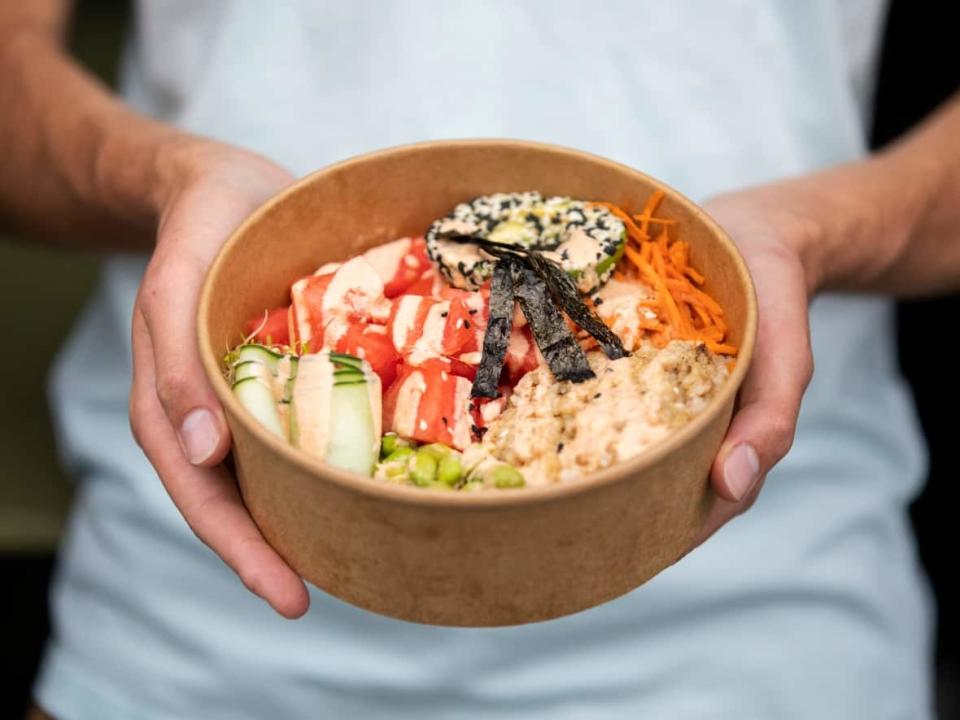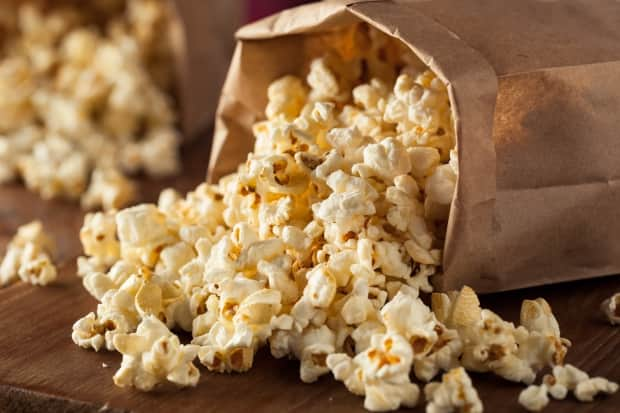Compostable takeout bowls contain 'forever chemicals,' study finds

If you bought a salad bowl for lunch in a compostable cardboard container, that greener choice may have come with a dash of "forever chemicals" called PFAS — and so do other kinds of paper food packaging in Canada, a new study suggests.
Should you worry? Here's a closer look at what those chemicals are, what food packaging they're found in most and what the findings of the study mean.
What are 'forever chemicals'?
PFAS (per- and polyfluoroalkyl substances) are a group of more than 9,000 human-made chemicals that contain fluorine bonded to carbon, a strong chemical bond that makes them hard to break down. That means they accumulate over time in the human body and the environment.
PFAS have been used for lubricants, stain repellents, waterproofing, non-stick coatings and firefighting foams, and can be found in products ranging from carpets to cosmetics to clothing to food packaging.
WATCH | Researchers uncover potentially toxic chemicals in makeup:
How harmful are they?
Very few PFAS have been studied in detail, but those that have been are linked to a variety of health effects in humans and animals, including increased risk of cancers, reduced immune response and fertility, and altered metabolism and increased risk of obesity.
Three groups of well-studied PFAS (PFOS, PFOA and LC-PFCAs) are prohibited in Canada because of their risk to the environment. PFOA and PFOS are among the six PFAS that the U.S. Environmental Protection Agency proposed regulating in drinking water earlier this month.
"We know that some PFAS are toxic," said Miriam Diamond, professor at School of the Environment at the University of Toronto and senior author of the new study. "We don't know whether all PFAS are toxic because there are too many to study."
Health Canada says there's evidence other PFAS that are replacing banned PFAS are also associated with environmental or human health effects. That's why the government is considering regulating all PFAS as a group.
In the meantime, levels of PFAS are detectable in the blood of Canadians and the Government of Canada is continuing to monitor for certain chemicals. As of 2016 and 2017, 98.5 per cent of Canadians had PFAS in their blood. It has even been found in the blood of people in remote northern Indigenous communities in levels that were sometimes similar to levels in people farther south.
LISTEN | Understanding the risks of 'forever chemicals':
Why are they found in food packaging? What kinds?
PFAS are commonly used to make paper grease-resistant, so they are used in many fast-food containers and wrappers. In that sense, finding them was no surprise. But the researchers wanted details about Canadians' exposure to PFAS through paper food packaging.
In the new study, published Tuesday in the journal Environmental Science and Technology Letters, researchers from Canada, the U.S. and Switzerland tested 42 kinds of paper food packaging collected in Toronto between February and March 2020, including compostable paper bowls, sandwich and burger wrappers, popcorn serving bags, and bags for desserts such as doughnuts.

Many of these kinds of packaging may become more common in Canada following a ban on the sale of many kinds of plastic takeout containers starting last December.
One thing that food packaging manufacturers have started doing to reduce the risk of PFAS exposure is making bigger PFAS molecules. They're billed as being too heavy to "escape" from the packaging, noted the researchers of the new study in a news release. The researchers wanted to look into the impact of that as well.
How did the researchers measure levels of PFAS in the food packaging?
The researchers, led by Heather Schwartz-Narbonne, a graduate student in environmental chemistry at the University of Toronto, first tested the packaging for fluorine, a key element in PFAS.
Forty-five per cent of the samples contained fluorine, suggesting they contained PFAS. Diamond said the researchers weren't aware of any other possible sources of fluorine in the packaging.
Three bowls and five paper bags with high fluorine were then tested for specific kinds of PFAS using different techniques that separate out and identify individual compounds in a mixture.

What did they find about PFAS in paper food packaging?
The highest levels of fluorine and PFAS were found in:
Some paper bags for greasy items such as burgers, pastries and doughnuts.
Compostable paper bowls. The researchers suggested that was because the raw pulp needs to be mixed with a lot of PFAS to make it strong enough and prevent disintegration when it comes in contact with liquids.
The bag and bowl samples each contained five to 14 different PFAS. The most common were 6:2 FTOH, which is known to be toxic to rodents and can be produced by the breakdown of the bigger, heavier PFAS that packaging manufacturers are now using.
By retesting the packaging two years after the samples were collected, the researchers discovered that the larger PFAS, intended to be too big to escape from the packaging, were indeed breaking down — concentrations declined by 85 per cent over that time.
WATCH | Toxic chemicals found in some Shein, AliExpress and Zaful clothes:
What happens when this compostable packaging is composted?
Brown is concerned that it could contaminate compost, "and then the compost is applied to land. It could be taken up by the vegetables that you eat," she said, adding that it would eventually find its way into the water.
Sally Brown, a research associate professor at the University of Washington who studies the use of waste such as municipal compost as resources, confirmed that PFAS don't break down in the composting process.
But she says there's already so much of them in the environment from other sources that the extra from your burrito bowl won't make a difference — so go ahead and put it in the green bin when you're done.
She added that people's direct or indirect exposure to PFAS from compost, such as through plants grown in the compost, is going to be minimal compared to other exposures.
"It's going to be a much bigger concern if you have it in something that you eat."

How worried should we be about this?
The researchers say PFAS are known to get into food from packaging that holds the food.
"It's getting into you because the PFAS will migrate from the packaging, from the bowl, from the bag into the food," said Diamond. Previous studies have shown that happens more quickly when food is hot and greasy, she added.
Joshua Garcia-Barrios is a graduate student researcher at the Waterloo School of Public Health Sciences who has measured PFAS exposure in northern indigenous communities, but wasn't involved in the new study. He said right now, there's not enough data to say what levels of which PFAS are going to cause which health effects. But he added it's useful to know about potential exposure through compostable packaging so people can think about how to reduce their risk.
"We do know that at a certain level there might be health impacts," he said.

What can be done to reduce the risk?
Diamond said she hopes the work provides a bigger push for the food packaging makers, restaurants and governments to restrict the use of PFAS and use safer alternatives that are already available.
When asked about the new study, Environment Canada told CBC News that it in addition to banning some kinds of PFAS and looking into regulating others, in coming months, the government will release a "state of PFAS report" that will facilitate further discussions.
PFAS have already also been regulated in food packaging in 11 U.S. states.
Some major chains such as McDonald's and Burger King have said they will ban PFAS in food packaging globally by 2025. The two companies are being sued in the U.S. over their use of PFAS.
The European Chemicals Agency is currently accepting comments on a proposal to ban the production, use and sale of about 10,000 PFAS in the European Union.
In the meantime, Garcia-Barrios suggested people may want to reduce exposure by eating out less, using different kinds of packaging and thinking about reusable containers. But they may also want to advocate for changes to regulations.
Cindy Luppi is New England director for Clean Water Action, a U.S. group focused on preventing harm to health from toxic pollution that has a campaign focused on stopping PFAS pollution by pressuring retailers to stop using it. The group has a shopper's guide to avoiding PFAS. It recommends looking for compostable food packaging products that are certified by the Biodegradable Products Institute, which requires it be PFAS-free, and provides links to other lists of PFAS-free packaging.
However, Luppi says single-use packaging is "never a great idea" and she recommends moving to non-toxic reusable packaging to reduce other kinds of pollution too.

